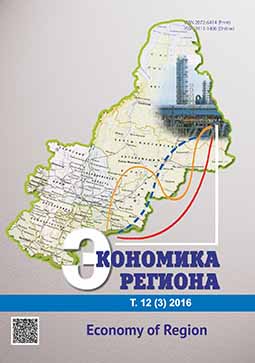Моделирование роли государства в пространственной агент-ориентированной модели
Simulation of the Role of Government in Spatial Agent-Based Model
Author(s): Viktor Ivanovich Suslov, Tatyana Sergeevna Novikova, Aleksandr Anatolyevich TsyplakovSubject(s): Economy
Published by: Институт экономики Уральского отделения Российской академии наук
Keywords: agent-based modelling; spatial economy; government policy; public goods; social transfers; taxation; state enterprises; social welfare function; economic efficiency; social justice;
Summary/Abstract: The paper describes the further development of an agent-based multiregional input-output model of the Russian economy. We consider the idea of incorporating the government into the model and analyze the results of experimental calculations for the conditional example of spatial economy. New agents are included into the model such as the federal and regional governments, pension fund and also the state enterprises producing public goods at the federal and regional levels. The government sets four types of taxes (personal and business income taxes, VAT and payroll taxes), ensures the provision of public goods and provides social, investment and interbudgetary transfers to households, firms and budgets. Social transfers consist of social assistance and unemployment benefits. The utility functions of households are expanded by the terms associated with national and regional public goods. The budget policy is designed in accordance with the maximization of isoelastic function of social welfare that formalizes the choice between the different concepts of social justice. The Gini index is used for the monitoring the inequality of income distribution. The results of experimental calculations present the convergence of the new version of the model to the state of quasi-equilibrium. The special attention is paid an optimal level of the taxation maximizing the social welfare function. Four variants of the optimal tax rates are defined: for three major taxes at a fixed proportion of rates and for each of the tax separately at zero rates of two other taxes. The further directions of modelling are identified, they allow to investigate the spatial development of the Russian economy taking into account the decision-making by private agents in responding to government policies.
Journal: Экономика региона
- Issue Year: 12/2016
- Issue No: 3
- Page Range: 951 - 965
- Page Count: 15
- Language: Russian

